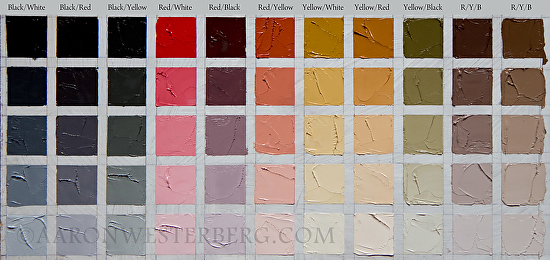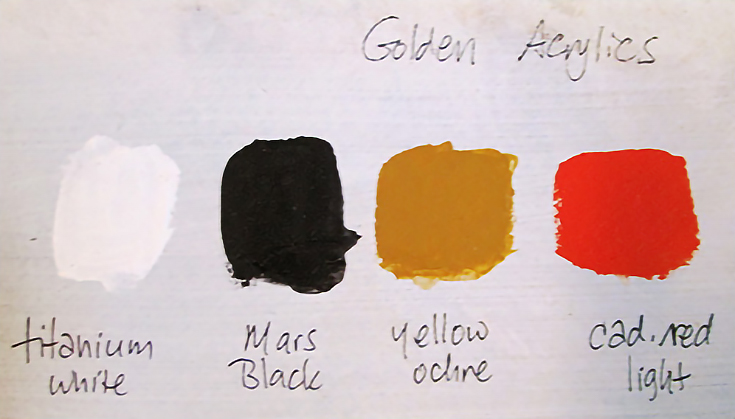The Zorn Palette is a super simple and powerful way to paint using just four basic colors. It’s named after Anders Zorn, a famous Swedish painter who mastered this limited color palette and still created beautiful, realistic portraits and scenes. Even though it uses only four paints, the Zorn Palette can create a wide range of skin tones, shadows, lights, and moods. Whether you’re a complete beginner or someone who wants to improve their painting without feeling overwhelmed, this palette is the perfect place to start. With just a few paints, you can learn the real magic of mixing colors and focusing more on values, contrast, and form.
What’s the Zorn Palette Made Of?
The traditional Zorn Palette is made up of just four paints:
- Yellow Ochre
- Cadmium Red (or Vermilion)
- Ivory Black
- Titanium White
That’s it. No blues. No greens. No purples. Yet, this small group of colors can mimic a full range of tones, especially for painting skin, which is why it’s often used for portrait painting for beginners. Ivory Black acts like a very dark blue when mixed with white, and when you combine it with the earthy Yellow Ochre and warm Cadmium Red, you can create beautiful neutrals and rich tones. Adding Titanium White helps adjust the values and brightness of your mix. This limited palette helps you focus on value and temperature more than choosing from a rainbow of colors.
Why Do Artists Love the Zorn Palette?
Artists love the Zorn Palette because it removes the stress of choosing from too many colors and lets you concentrate on the fundamentals of painting. It trains your eye to see how light and shadow work together. Many beginners get lost in choosing fancy blues, greens, and purples—but the Zorn Palette shows you that you can paint almost anything using just a simple color palette.
Another reason why it’s loved by professionals and beginners alike is because it helps avoid “muddy colors.” With fewer choices, it’s easier to learn how colors interact. This means better color harmony, and your paintings will look more balanced.
Even famous painters today use the Zorn Palette as a practice tool. It’s especially great for skin tone painting techniques, as it allows natural warmth and subtle shifts in tone without overcomplicating things.
How to Start Using the Zorn Palette
Starting with the Zorn Palette is actually really easy. All you need are four tubes of paint and a basic surface to paint on. If you’re doing oil painting, go for artist-grade colors in Yellow Ochre, Cadmium Red, Ivory Black, and Titanium White. For acrylic or gouache, you can still follow the same palette names.

Once you have your paints, squeeze out small amounts on your palette and start by mixing colors before putting anything on canvas. You’ll notice how Ivory Black + White = Blue-gray. Add Yellow Ochre and it becomes a muted green. Red + Yellow = orange. By playing with these combinations, you’ll learn to see color temperature and value.
Here’s the best part—you don’t need to be perfect. Just start painting small studies like faces, hands, or objects in one light source. Don’t worry about details yet. Focus on shape, shadow, and how to mix warm vs cool colors.
Best Paint Brands for Zorn Palette
If you’re wondering what paints to buy, here are some trusted brands that make great versions of the Zorn colors:
- Winsor & Newton Artists’ Oil Colour
- Gamblin Artist Oils
- Michael Harding Handmade Oils
- Rembrandt Oils
- Liquitex (for acrylic painters)
These brands have rich pigments and are perfect for painting with a limited palette.
What Paper or Canvas Works Best?
For oils or acrylics, pre-stretched canvas or canvas boards are ideal. If you’re just practicing, canvas paper pads are budget-friendly and work great. If you’re using gouache or watercolor with the Zorn Palette colors, choose heavyweight watercolor paper (at least 300 gsm) so it doesn’t buckle.
Brushes That Help You Paint Better
For beginners, don’t overthink it. Start with:
- Flat brushes (for blocking shapes)
- Round brushes (for details and blending)
- Filberts (a favorite for smooth edges)
Synthetic brushes are easier to clean, but natural hair gives a better “feel” if you’re painting in oils.
Mixing Colors Like a Pro with the Zorn Palette
Mixing colors with the Zorn Palette is where the fun begins. Since you only have four paints, you’ll need to mix to create everything. Start by understanding warm vs cool. Cadmium Red is warm. Ivory Black is cool. Yellow Ochre is earthy and warm. When you start mixing these with white, you’ll see how easily you can control your values.
Want to make a shadow tone? Try Ivory Black + Red. Need a highlight? Yellow Ochre + White. Want a neutral skin tone? Mix all three colors with some white and adjust based on what you need more of.
This kind of color mixing teaches you control, balance, and sensitivity—exactly what every beginner painter needs.
Can You Paint Everything with Just 4 Colors?
Yes—and that’s the power of the Zorn Palette. Even though you don’t have blue or green in your palette, you can imply those colors through smart mixing. The cool gray from Ivory Black and White can feel like blue in shadows. Warm mixes can feel like green when placed next to warmer tones.
This technique is often called optical mixing—our eyes fill in the color gaps. This is why the Zorn Palette is great for creating realistic skin tones, portraits, and mood-rich paintings without having to deal with color chaos.
So while you may not be painting bright tropical jungles with this palette, you absolutely can paint people, animals, still life, and even landscapes.
Tips to Practice with the Zorn Palette Every Day
Practicing daily, even for 15-20 minutes, will dramatically improve your painting skills. Here are some ways to make the most of the Zorn Palette:

- Stick to small studies: Paint parts of the face, hands, or objects in light and shadow.
- Use black and white photos as references to understand value.
- Compare warm and cool tones as you mix.
- Don’t use more than 4 paints. The goal is to master control, not variety.
By sticking to a limited palette, your brain learns faster how colors behave.
Try Painting Faces First
Faces are full of warm and cool areas—perfect for the Zorn Palette. Try painting a simple portrait using just the four colors. You’ll be amazed how lifelike it looks without ever reaching for blue or green.
Use Light and Shadow Tricks
The Zorn Palette teaches you that value matters more than color. Use light and dark shapes to define your forms. Practice painting objects under a single lamp to understand how light creates depth.
Common Mistakes Beginners Make (And How to Avoid Them)
- Using too much red: It can overpower the mix. Start small.
- Not mixing enough paint: Always mix a little extra.
- Ignoring values: Focus on light vs dark, not just color.
- Adding extra colors too soon: Stick to four paints until you feel confident.
What Did Anders Zorn Paint With This Palette?
Anders Zorn, the master behind the palette, painted portraits, nudes, and scenes from everyday life using this exact limited palette. His works are known for their lifelike skin tones, warm lighting, and soft shadows. Zorn believed that too many colors could distract from the form and feeling of a painting. By limiting himself, he pushed his painting techniques and trained his eye to see more with less. His approach is still taught in art schools and workshops today.
The Bottom Line
The Zorn Palette may look simple on the surface, but it’s one of the most powerful ways to learn painting. By sticking to just four colors—Yellow Ochre, Cadmium Red, Ivory Black, and Titanium White—you’ll learn how to mix, match, and paint like the masters. Whether you want to paint portraits, still life, or realistic scenes, this limited palette gives you the perfect tools to start your art journey without the confusion of too many choices.
Best of all, it’s easy to learn and hard to mess up. Even a 10-year-old can pick it up and start painting. So don’t wait—grab your four colors and start creating amazing art with the Zorn Palette today.


